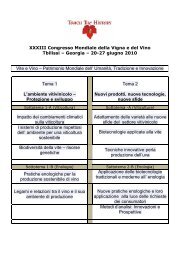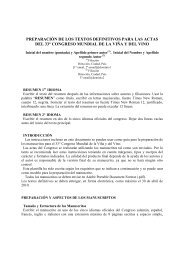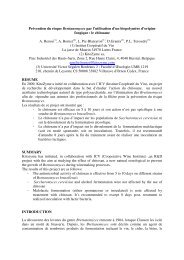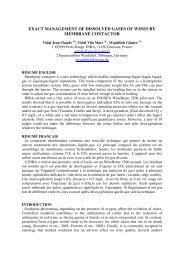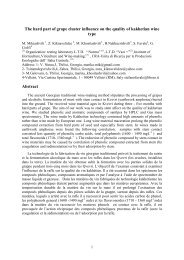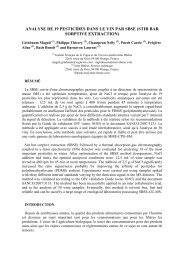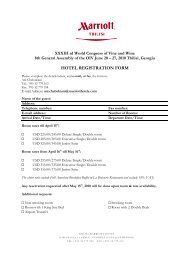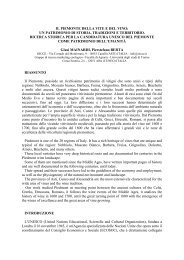Some Biological Activities of Vine Stilbens and New ... - Oiv2010.ge
Some Biological Activities of Vine Stilbens and New ... - Oiv2010.ge
Some Biological Activities of Vine Stilbens and New ... - Oiv2010.ge
You also want an ePaper? Increase the reach of your titles
YUMPU automatically turns print PDFs into web optimized ePapers that Google loves.
engaged in an intense study in the direction <strong>of</strong> “Wine <strong>and</strong> health” to identify specifically the<br />
stilben spectrum in red Georgian wines. At present, we have identified <strong>and</strong> determined<br />
resveratrol dimmer ε-viniferin.<br />
MATERIALS AND METHODS. We used the different types <strong>of</strong> naturally cleared red<br />
wines made with Saperavi, Otskhanuri Sapere, Cabernet Sauvignon <strong>and</strong> Tavkveri species as<br />
the objects <strong>of</strong> the study, in particular, dry table, naturally semi-sweet, semi-sweet <strong>and</strong> fortified<br />
wines. For qualitative <strong>and</strong> quantitative analyses <strong>of</strong> trans-resveratrol, we extracted the wines in<br />
advance with ethyl acetate <strong>and</strong> used the gained fraction for analyses. We used thin-layer<br />
chromatography with silufol plates (20 cm x 20 cm), system: chlor<strong>of</strong>orm : methanol (80:20)<br />
<strong>and</strong> denitrated sulfanilic acid as a developer. We defined the quantity <strong>of</strong> trans-resveratrol by<br />
high-efficiency liquid chromatography in terms <strong>of</strong> gradient. The column <strong>of</strong> Nucleosil C 18 ,<br />
eluent A: water + H3PO4; eluent B: acetonitrile+H3PO4, pH=3,5-4,0. Out <strong>of</strong> naturally cleared<br />
dry table bulk wines made with the 2008 harvest <strong>of</strong> Saperavi <strong>and</strong> Cabernet Sauvignon, we<br />
isolated the total stilbens with further treatment <strong>of</strong> their ethyl acetate fractions (Ribeiro de<br />
Lima et al., 1999). We analyzed the gained fraction by high-efficiency liquid chromatography<br />
in terms <strong>of</strong> gradient (the chromatograph made by “Varian”); UV detector/visible spectrum,<br />
column – Microsorb 100 C18, 250X4,6 LxId (mm); 5µm – Particle Size. Eluent A: TF<br />
(trifluoroacetic acid) 0,025% water solution; eluent B: AСN/AA, 80/20 (v/v); (Guebailia, et<br />
al., 2006).<br />
RESULTS AND DISCUSSION. The gained results demonstrate that the concentration <strong>of</strong><br />
trans-resveratrol in bulk wines depends on different factors, one <strong>of</strong> which is the generic factor.<br />
In this respect, Saperavi <strong>and</strong> Otskhanuri Sapere are the most obvious examples. The<br />
concentration <strong>of</strong> trans-resveratrol in bulk wines also changes according to the sugar content <strong>of</strong><br />
the must. In particular, within the range <strong>of</strong> 19,1-26,0%, the content <strong>of</strong> trans-resveratrol in the<br />
red wines made <strong>of</strong> Saperavi with different sugar contents changes from 1,69 mg/l to 2,87<br />
mg/l; for Otskhanuri Sapere (with the sugar content <strong>of</strong> 19,2%-22,4%), it is 1,25 mg/l 1,95<br />
mg/l <strong>and</strong> for Cabernet Sauvignon (with the sugar content <strong>of</strong> 19,3%-22,7%), it is 1,15 mg/l to<br />
2,25 mg/l. At this point, in addition to the generic factor, the factor <strong>of</strong> alcohol-content <strong>of</strong> the<br />
pomace fermented is obviously seen. As for the wine type, it is seen as the factor making the<br />
wines made with the same grape species significantly different from one another with their<br />
concentration <strong>of</strong> trans-resveratrol. This is proved by the diagram in “Fig. 1”.<br />
“Fig. 1”. Change <strong>of</strong> the concentration <strong>of</strong> trans-resveratrol according to the types <strong>of</strong> wine.<br />
I – naturally semi-sweet, II – semi-sweet, III – dry, IV – fortified.<br />
Among the naturally semi-sweet, semi-sweet, dry <strong>and</strong> fortified wines, the concentration <strong>of</strong><br />
trans-resveratrol is the highest in the fortified wine <strong>and</strong> is the least in the naturally semi-sweet<br />
wine. Besides the above-mentioned factors, temperature <strong>and</strong> squeezing <strong>and</strong> mixing <strong>of</strong><br />
4



